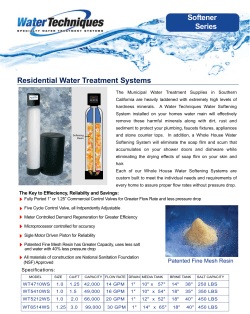
Operational Strategies to Control Energy Bills OWEA Plant Operations Workshop May 22, 2014
Operational Strategies to Control Energy Bills OWEA Plant Operations Workshop May 22, 2014 Kevin Krejny My Goals of Presentation • Give real numbers, problems, solutions from Ohio WRF. In regards to energy costs • Understand your energy costs and needs • Operational Strategies to lower energy costs • Touch on energy purchasing strategies • Show how to track that you are getting better • Show that with any style or size plant, there are energy savings available Western Regional WRF Montgomery County Water Reclamation (since 2008) • Flow- Avg. 14.94 MGD Median 13.81 MGD • 12.25 MGD Summer 15.59 MGD Winter 20.0 MG Design • TSS Loadings – Avg. 22,559 lbs Median 19,939 lbs • 22,141 lbs summer • 22,960 lbs winter 55,000 lbs Design Ammonia Loadings – 1800 lbs per day • cBOD Loadings – Avg. 24,628 lbs • 24,651 summer Median 23,583 lbs 24,605 lbs winter 38,400 lbs Design • We have lots of concrete, what technology is in the concrete is old, inefficient, and creates constant headaches. But we have started to fix that. Other Facilities • Fairborn WRF – 4.5 years • Clark County SW Regional WRF – 2.5 years • Greene County – 1 year o o o o Beavercreek WRF Sugarcreek WRF Cedarville WRF Clifton WRF kWh WRF Energy usage (keep in simple) • Aeration o Activated Sludge o Digestion • Pumping o Influent o Internal plant elevation o RAS/WAS • Other o Lighting • Indoor • Outdoor o HVAC o Dewatering o Ultraviolet Disinfection Aeration • 40-60% of total usage depending on plant type o Activated Sludge/Aerobic Digestion - up to 60% o Trickling Filter (pumping needs)/Anaerobic - less than 20% o Many combinations • Activated Sludge o Ammonia and cBOD removal o Lower MLSS could mean less aeration (tanks) needed o Look at ammonia effluent • If <0.25 mg/l, likely over aerating • Know your permit limits, no or high winter ammonia, can turn back • Aerobic Digestion o If going landfill – weigh aeration energy costs vs. VS destruction o Once pass 503 reg parameter (i.e. SOUR test), turn back air o DO >2/0 mg/l can turn back aeration Jet Aeration vs. Fine Bubble Diffusers Fine Bubble Diffusers Increased Efficiency Jet Aeration Tanks MLSS Average 3206 lbs solids in Instanteous average aeration Flow cfm 89127 16.2 3048 Fine Bubble Tanks 30 min Settle ammonia (mg/l) SVI Average cfm 30 min Settle ammonia (mg/l) 281 2.65 88 2026 270 1.70 % less 33.5% 3.9% 36.0% Last year side by side comparison Western Regional WRF 700 HP Huffman Multistage Centrifugal Blowers Newer technologies 10-15% more efficient aeration kWh per lb cBOD 1/1/08 to present 2.50 1,400,000 1,300,000 2.00 1,200,000 1,100,000 1.50 1,000,000 900,000 1.00 800,000 700,000 0.50 600,000 0.00 500,000 aeration kWh per lb cBOD influent cBOD lbs Linear ( aeration kWh per lb cBOD) Linear (influent cBOD lbs) Pumping • Proper sized pumps o Likely oversized to meet peak demand that might only occur 5% of year o Great to have various sized pumps and use combinations o Use wet well height to help keep pumps in the proper area of pump curve • Variable Speed Frequency Drives (VFD) o Replace old VFD’s o 10 years old, might not be doing what they were designed to do o Help to keep pump running in sweet spot of curve • High/premium efficiency motors o More hours on motor, more payback with switching over • Clean/replace Air Relief Valves (Next slide) • Track MG pumped/kWh used o o o o Great if pumping station separate from rest of plant Only true way to measure if your changes are working Cannot use $$$, because this cost changes yearly A kWh is always a kWh + a MG pumped is always a MG pumped 1,300 1,200 Variable Frequency Drive and Air Relief Valve Improvements Made in Early 2013 kwh/MG Pumped at Pre-Treatment (2008-13) 1,100 1,000 Avg 802 kwh/MG 900 Avg 695 kwh/MG 800 700 600 13.3% Reduction 500 AVR replaced 1/1/13 VFDs Installed 2/1/13 400 kwh/MGD (PTP) after ARV Linear (kwh/MGD (PTP)) Linear (after ARV) Return Activated Sludge (RAS) • Turn down you RAS rates o o o o o o o o o It is the pounds of RAS returned, not the flow 7,500 mg/l @ 2 MGD = 10,000 mg/l @1.5 MGD = 15,000 mg/l @ 1.0 MGD Benefit of increase detention time in aeration basins Promotes Biological Nutrient Reduction (BNR) Less Nitrate coming back around Reduces RAS pump usage WAS is thicker going to digester Reduce supernate efforts Less volume needed for digestion – could prevent the need for more concrete HVAC • Know your staffing and building needs • DO NOT heat/cool building to 70 degrees that people enter only once a day • Use windows/doors to self regulate air flow and temperature needs • Never run a heater in a blower room • Buildings below ground rarely need Heat/AC, maybe ventilation • Moving water will not freeze in a building • Natural gas cheaper than electric heat, right now • Electronics like cold not heat Lighting • Use motion detection to turn on/off lighting • Outside lighting o o o o Should evaluate how much is needed (know where people work) Is plant staffed 24/7 or not Light sensors to turn on/off daily You do not need to play football at a WRF • Replace old lights with LED Make sure they get enough hours of use Do not need LED on a light that is used once a day for a plant check Replace aging/high use lights first with LED The more hours a light is on, the more savings you get and faster pay back in a LED lighting upgrade o Adding savings of longer life, less time replacing bulbs o o o o FACT • It does not matter how you are billed for electricity, moving electrical usage off peak and keeping a steady load profile all day and year will save you money. Energy billing options • Tariff pricing o What energy supplier in your area has written in numerous tariffs o Changes several times a year, hard to follow and confirm being billed properly • Fixed Pricing o One set cost per a period of time o Usually 1-2-3 years o All inclusive • Index Pricing o o o o Energy price changes hourly Based on regional demand and usage Can be very good at certain times Can keep you up at night at other times •What do they all have in common? Answer • They all have a Historical Peak Demand component specific to your facility in the bill • This can be great it you control and predict your peaks o Peaks are set at the five highest hours, on different days, from the previous year o Usually set during afternoon of 90 degree plus days in July or August o 2013 were all from one week in July PEAK LOAD (MW) PJM RTO DATE HOUR ENDING 7/18/2013 17 (5pm) 157,509 7/19/2013 15 (3pm) 156,077 7/17/2013 17 (5pm) 154,044 7/16/2013 17 (5pm) 151,421 7/15/2013 18 (6pm) 150,315 Delivery Year: 2009-10 $ 102.04 First Energy $ 102.04 DPL/Duke/AEP 2010-11 $ 182.85 $ 182.85 2011-12 $ 116.15 $ 108.89 2012-13 $ 16.74 $ 20.46 2013-14 $ 28.37 $ 28.37 2014-15 $ 128.17 $ 128.17 2015-16 $ 134.62 $ 342.30 2016-17 $59.37 $114.23 SO WHAT Can you do • Turn off or back as many treatment processes as you can for a couple hours during these days o Minimal treatment for three hours will not effect your 24 hour composite sample that much o Fill wet wells and turn off digester aeration o Stop dewatering o Stop RAS/WAS, can get caught up later by increasing rates o Turn your aeration back as much as possible o Remember during these 5 hottest days, you are likely to have your lowest flows of the entire year o If you have newer emission friendly generators you can run them to completely get off the grid o RICE NESHAP started 5/3/2014 reduces options to control these charges Running Plant generator (12 times) hit all 5 peak hours Money saved (7/147/15) Money spent/ results • • • Fuel = (4800 gal * $3.50) = $16,800 Labor = (12 days*3 hr*$35/hr*1.145 OPERS) = $1,442 $18,242 Spent – no DPL bill during time ($12, 560) •Cost of $5,682 • • • Doing nothing Capacity Charge $89,404 We spent $5,682 to go off the grid Capacity Charge for (7/14 7/15) = $5,611 • Total Savings = $78,111 Great Online tool • Updated regional usage every 5 minutes https://edatamobile.pjm.com/eDataWireless/SessionManager?a=instLoad Block and Index Pricing • Takes the certainty of Fixed Pricing (Block) and allows a portion of your usage to be on hourly index pricing Block and Index • Can combine several accounts for the block • Mixture of drinking water pumping and wastewater treatment help keep a flat profile of accounts • Lowest Block amount is 1 MW a month or 720,000 kWh per month • Can block of 1 MW intervals • Can do this at anytime or amount (pricing changes daily) • Suggest, if large enough, hire a energy broker to make these transaction and lead you through • If you can control energy needs through facilities for short periods of time, you can save a lot of money • Get to a flat load profile – Energy suppliers love knowing they have clients with consistent loads = cheaper pricing Questions or Corrections • Now or • Later krejnyk@mcohio.org
© Copyright 2025

















